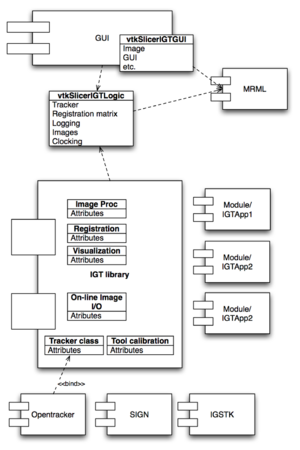Difference between revisions of "AHM 2007:Slicer3 Developer Feedback"
From NAMIC Wiki
(→IGT) |
|||
| Line 47: | Line 47: | ||
*January 4th, 2007 at 1249 Boylston | *January 4th, 2007 at 1249 Boylston | ||
Implementation strategy for IGT-Slicer is discussed and preliminary design proposed (by Hata and Liu) | Implementation strategy for IGT-Slicer is discussed and preliminary design proposed (by Hata and Liu) | ||
| − | [[Image:Slicer3-IGT-Architecture.png| | + | [[Image:Slicer3-IGT-Architecture.png|300px|thumb]] |
==Our timeline== | ==Our timeline== | ||
Revision as of 20:10, 6 January 2007
Home < AHM 2007:Slicer3 Developer FeedbackBack to AHM_2007#Wednesday.2C_Jan_10_2007:Project_Activities
Contents
Topics for this session:
- Information to the developer community about how these projects have approached developing their code for slicer3 (what's the architecture of their modules)
- Feedback to the base developers about what was easy or hard in the code writing
- What would they like to see in the slicer3 base and/or in VTK, ITK, KKWidgets, etc to make the module development more effective
DTI
DTI Module: Raul San Jose
Tractography Module: Lauren O'Donnell
Module Architecture
- Tractography is represented as a vtkMRMLFiberBundleNode. Display parameters are stored in a vtkMRMLFiberBundleDisplayNode, and storage (load/save) handled by vtkMRMLFiberBundleStorageNode. Basic operations of adding new fiber bundles, etc. are in vtkMRMLFiberBundleLogic.
- vtkMRMLFiberBundleDisplayLogic is needed to create "hidden" slicer models that will be rendered in the MRML scene. Otherwise base classes would have to be heavily edited to handle tractography display using the display node.
- There will be several slicer module units to handle tractography. The division will be by Load/Save/Display, Editing (to manually add, select, delete, or to use ROI selection), Seeding, etc.
- Initial work is on the Load/Save/Display and the entire MRML infrastructure.
Feedback on Slicer3
- When adding a new module and a new datatype, it is difficult to find the places in Base code that must be edited.
- It is also difficult to understand how the MRML callback happens, and how to set a new one up. It would be great to have a simple overview on the observers somewhere (or even the SVN web for easier code navigation).
- If a vtkMRMLNode inherits from another one used in slicer (for example mine inherits from the modelNode currently) then the subclass will show up on all of the superclass menus. This is because the vtk "IsA" function is used rather than a direct match. I believe this is feature that is not desired.
What I would like in Slicer3 base...
- More documentation, comments, etc.
EM
IGT
Noby Hata, Haiying Liu, Simon DiMaio, Raimundo Sierra
Hisotory of our involvement
- Summer 2006: Haiying Liu joined the core development team and translated MRAblation module from the Slicer 2.6. There he
- Learned the architecture of Slicer 3
- Got familiar with KWWidgets
- Fall 2006: Haiying Liu implemented IGT Demo module. There he
- Contributed vtkIGTDemoLogic and vtkIGTDemoGUI classes in the Base
- Added an option for CMake to link the external library opentracker
- December 2006: Two additional members joined IGT-Slier3 task force
- Simon DiMaio representing prostate robot project [PI Tempany1R01CA111288]
- Raimundo Sierra representing Neuroendoscope project [PI Jolesz 5U41RR019703]
- January 4th, 2007 at 1249 Boylston
Implementation strategy for IGT-Slicer is discussed and preliminary design proposed (by Hata and Liu)
Our timeline
- IGT tutorial demo on alpha (done)
- IGT tutorial demo on beta (during AHM week by Liu)
- Neurosurgical navigation with GE Nav (spring to summer)
- Building with IGSTK (during AHM week, by Hata)
- Neurosurgical navigationi with JHU robot (by March)
- Integration to MR/T (fall)
Feedback
- genutiltest.tcl is great!
- Request to create account for SVN has not been returned from Kitware. Cannot contribute codes to SVN tree.
- Guideline for creating library and modules would be helpful for those joining Slicer community. Template (blank) code may be helpful.
- Don't understand what "NA-MIC sandbox" means...
- Application-specific customization and streamlining of the GUI will be important for IGT applications. To what extent is this possible?
- Performance bounds are important to understand for IGT applications. Can we talk about determinism and performance as Slicer scales?
